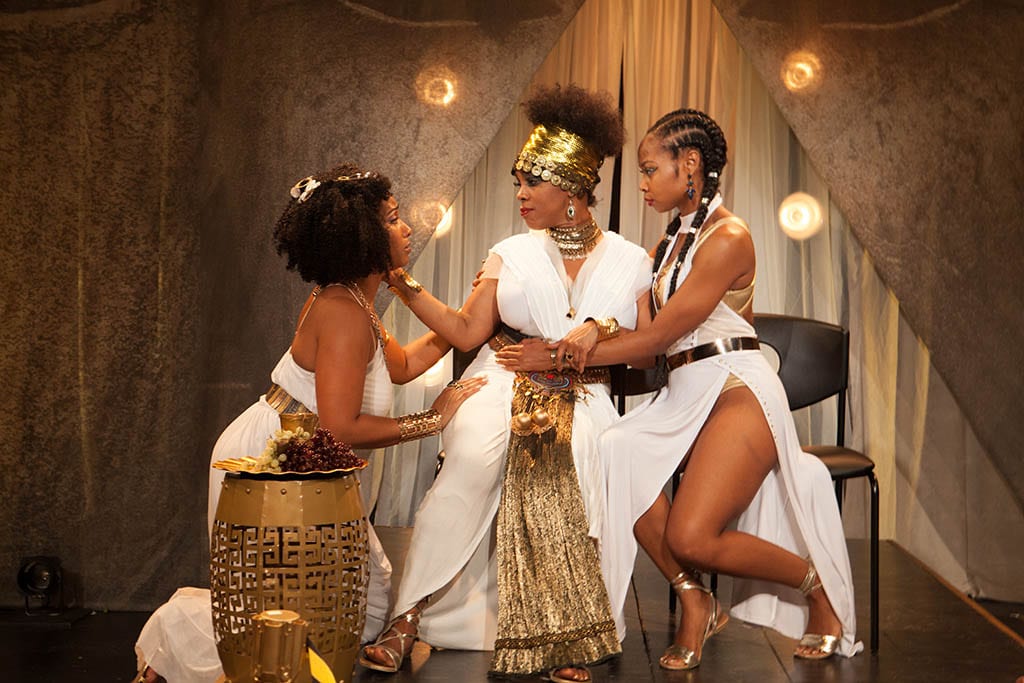Sex, power struggles, political intrigue, the tyranny of the patriarchy: these themes were as familiar three and a half thousand years ago as they are in this morning’s Twitter feed. Enter the world of 15th century Egypt, where Queen Hatshepsut is fighting for her right to rule – alone, without a man. Fit for a queen, the latest production of the Classical Theatre of Harlem, explores the story of a powerful woman looking to claim her birthright as the ruler of Egypt, changing history as she goes.
Written by Betty Shamieh, the play is bursting at the seams with female power, and not just on the page. With a female writer, director, and predominantly female cast, Fit for a Queen is refreshingly feminist. It’s a celebration of women throughout, from the inventive costumes evoking both ancient Egypt and modern femininity to the seductive authority of April Yvette Thompson as Hatshepsut. Though some scenes tend to lag, they are revived by the lively music and the brilliant ensemble of dancers in each effortless scene change. The music, the dancing, and the costumes all contribute to what is so compelling about Fit for a Queen. The play is incredibly visual and fun to watch, with bold props and beautiful clothing. White and gold robes, bright colors, and hieroglyphic drapery transform the room on all sides; the Classical Theatre of Harlem definitely makes good use of the space at the 3LD Art and Technology Center.
Women dominate the plot, from Hatshepsut to her daughter Neferure to Senenmut, Hatshepsut’s sworn servant and bedmate. Senenmut is perhaps the most interesting twist to the story of the rise of the female pharaoh. Based on an ancient Egyptian male advisor, she is born lower and rises higher than her namesake, refusing to let barriers like class or gender keep her down. Sheria Irving as Senenmut is the darling of the play: charismatic and delectably naughty, and not afraid to wield her femininity as a weapon.
We have the advantage of hindsight, however, to realize that women in history rarely come out on top. Scene after scene of women putting men in their place or asserting their (quite literally) god-given power are immense fun until the final scene, when the political machinations and jealousy that have been simmering throughout the course of the play explode. The men in the play are written in a contrast to their female counterparts that is both humorous and chilling. Hatshepsut’s husband Thutmose repeats the words “I am the pharaoh!” so many times that you stop believing him. Her son-in-law and rival to the throne is weak-willed and pouty in his every interaction. He seeks power like a petulant child and becomes an instant tyrant when he gets what he wants – aided not in the least by the patriarchy which would rather have him in power anyway, despite the qualifications of his female rivals. The message that Shamieh is sending here is hard to miss, and feels especially raw in today’s political climate: this story is a tragedy.
If you’re looking to go to the theater to forget the troubles of the world, Fit for a Queen is not that play – and that’s no accident. This play is bold in many ways: its fiery characters, its sensuality, its imagery, and how directly it deals with issues that still plague us as a civilization, more than 3000 years after the Egyptians. With Fit for a Queen, the Classical Theatre of Harlem has put on another solid production with its own unique flavor.

